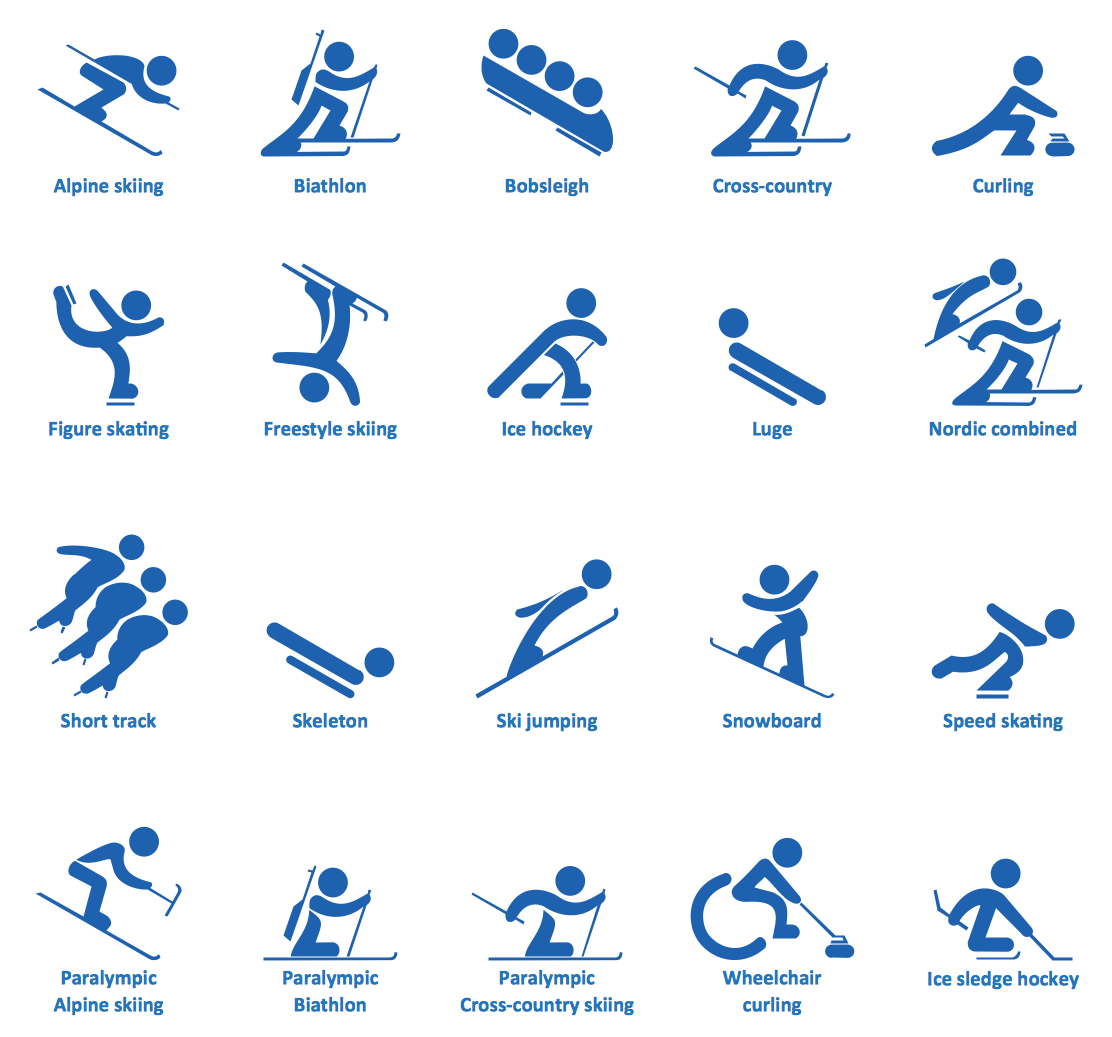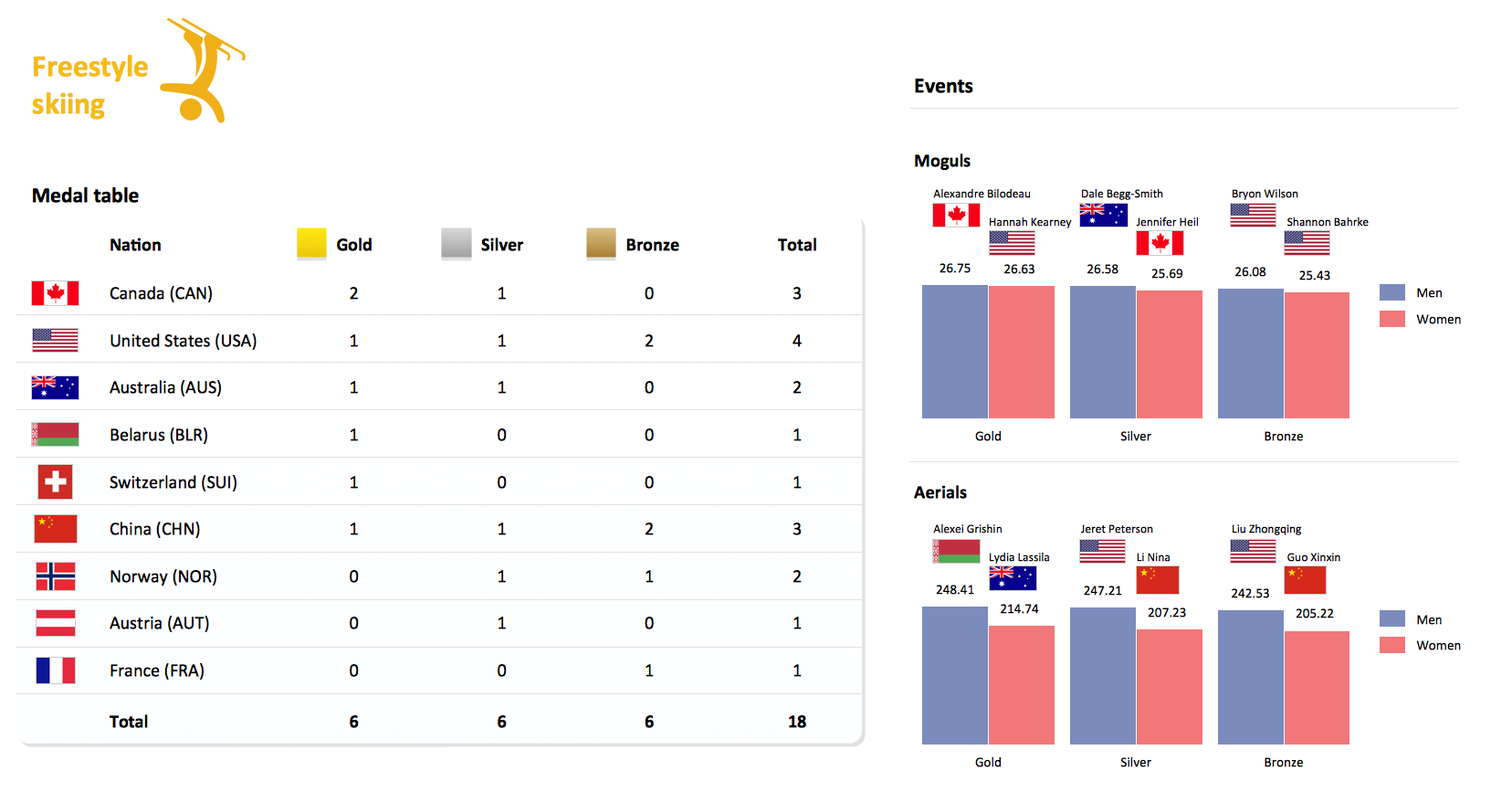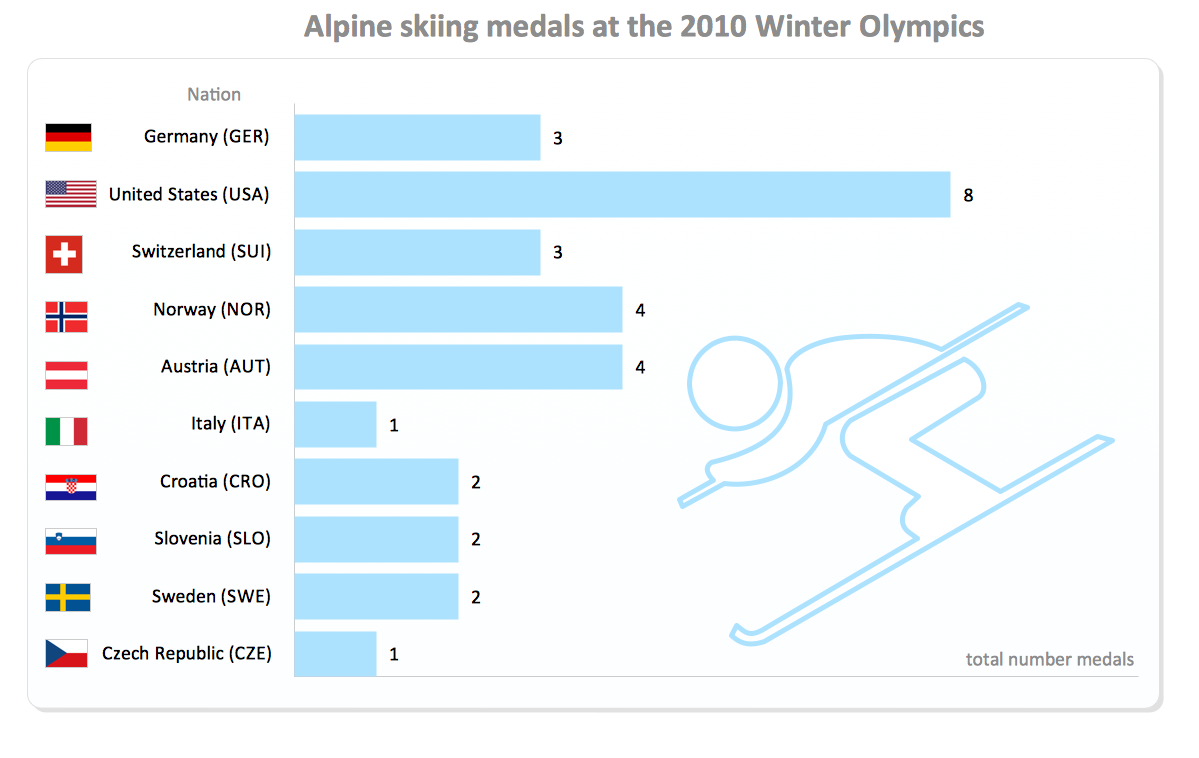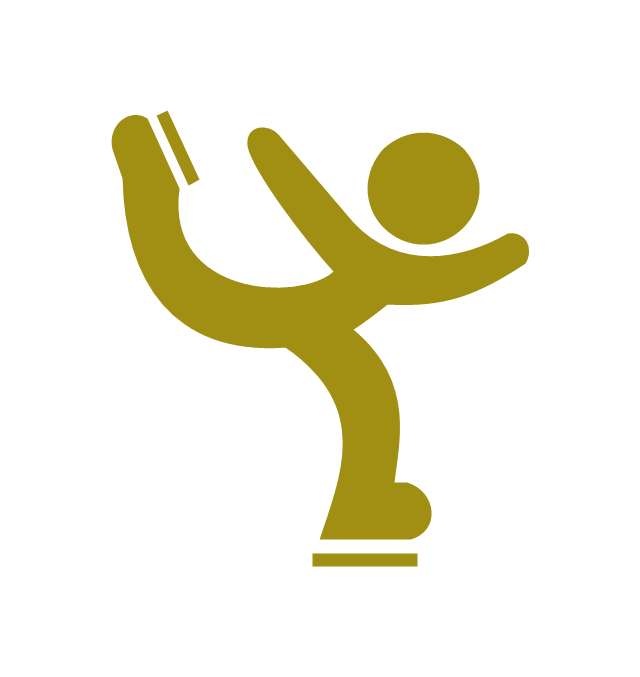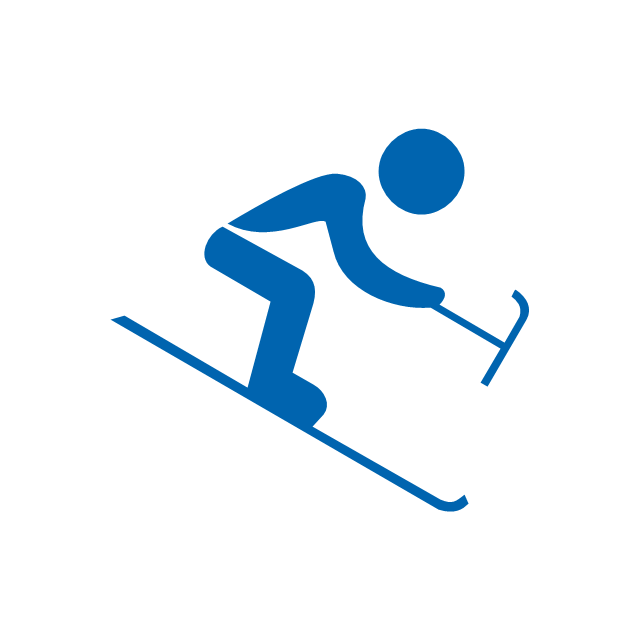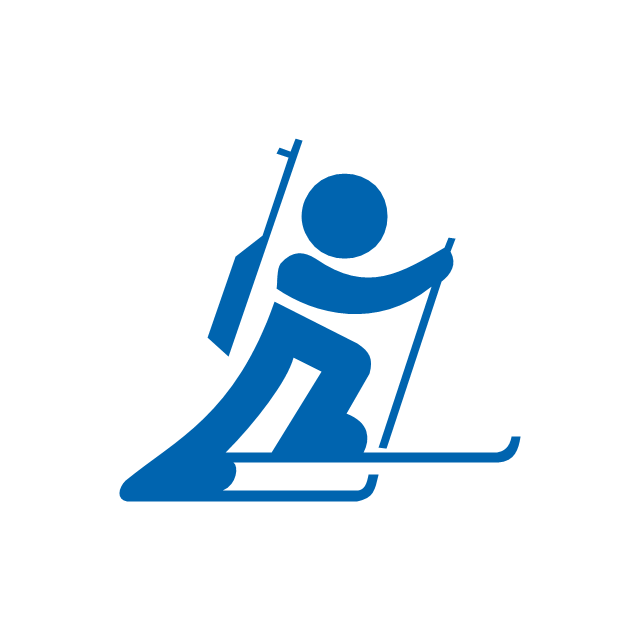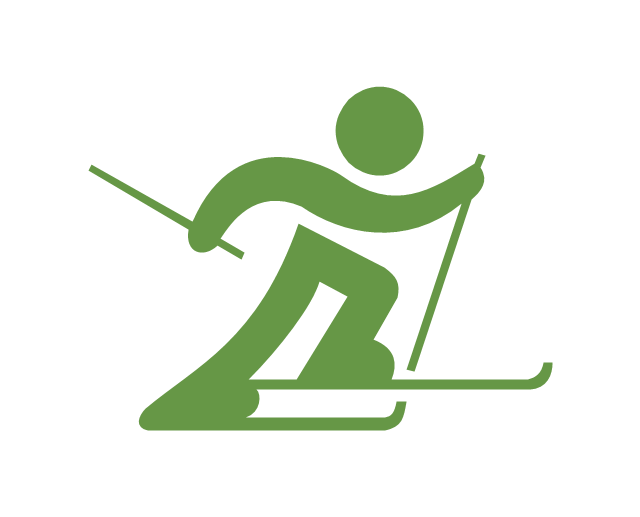 Winter Sports
Winter Sports
The Winter Sports solution from Sport area of ConceptDraw Solution Park contains winter sports illustration examples, templates and vector clipart libraries.
Winter Sports Vector Clipart. Medal Map. Spatial Infographics
Tracking Olympic results in visual format is the most modern way to deliver statistics to a broad audience. This is a good example of an illustrated table you may easily modify, print, or publish on web from ConceptDraw Winter Sports solution.Winter Sports. Using Olympic Games Clipart to Illustrate Tournament Schedule
The Winter Sports solution for ConceptDraw DIAGRAM provides you with a rich set of olympic games and winter sports pictogram you may need to illustrate tournament schedules or any other kind of information materials.Winter Sports. Using Winter Sports Design Elements Producing Infographics
The Winter Sports solution from Sport Area of ConceptDraw Solution Park contains winter sports pictogram you may use illustrating any kind of material about Olympic Games or any other sport competitions.Winter Sports. Olympic Games Illustrations. Medal Summary
Do you like infographics and data visualization? Creating infographics is super-easy with ConceptDraw.Winter Sports. Olympic Games Infographics. Medal Table
Visualizing data in infographics format is a modern way to represent any statistics related to global sporting events, such as Winter Olympic Games. ConceptDraw DIAGRAM software extended with the Winter Sports solution delivers a rich set of samples and templates helps you produce all kind of sporting information, such as tournament schedule or medal table.Winter Sports. Illustrations and Visualize Statistics
Visualizing sports statistics becomes as easy as never before with ConceptDraw DIAGRAM software extended with the Winter Sports solution. This solution delivers a complete set of winter sports illustrations, samples and templates you may use to visualize any kind of sports statistics in minutes."Skeleton is a fast winter sliding sport in which an individual person rides a small sled down a frozen track while lying face down, during which athletes experience forces up to 5g. It originated in St. Moritz, Switzerland as a spin-off from the popular British sport of Cresta sledding. Although skeleton "sliders" use equipment similar to that of Cresta "riders", the two sports are different: while skeleton is run on the same track used by bobsleds and luge, Cresta is run on Cresta-specific sledding tracks only. Skeleton sleds are steered using torque provided by the head and shoulders. The Cresta toboggan does not have a steering or braking mechanism although the Cresta riders use rakes on their boots in addition to shifting body weight to help steer and brake. The sport of skeleton can be traced to 1882, when soldiers in Switzerland constructed a toboggan track between the towns of Davos and Klosters. While toboggan tracks were not uncommon at the time, the added challenge of curves and bends in the Swiss track distinguished it from those of Canada and the United States. ...
In 1923, the Federation Internationale de Bobsleigh et de Tobogganing (FIBT) was established as the governing body of the sport. Soon afterward, in 1926, the International Olympic Committee declared bobsleigh and skeleton as Olympic sports and adopted the rules of the St. Moritz run as the officially recognized Olympic rules. It was not until 2002, however, that skeleton itself was added permanently to the Olympic program with the 2002 Winter Olympics in Salt Lake City, Utah." [Skeleton (sport). Wikipedia]
The vector icon example "Skeleton" represents one of 20 symbols from the Winter sports pictograms library for the ConceptDraw PRO diagramming and vector drawing software.
The design elements library Winter sports pictograms is included in the Winter Sports solution from the Sport area of ConceptDraw Solution Park.
In 1923, the Federation Internationale de Bobsleigh et de Tobogganing (FIBT) was established as the governing body of the sport. Soon afterward, in 1926, the International Olympic Committee declared bobsleigh and skeleton as Olympic sports and adopted the rules of the St. Moritz run as the officially recognized Olympic rules. It was not until 2002, however, that skeleton itself was added permanently to the Olympic program with the 2002 Winter Olympics in Salt Lake City, Utah." [Skeleton (sport). Wikipedia]
The vector icon example "Skeleton" represents one of 20 symbols from the Winter sports pictograms library for the ConceptDraw PRO diagramming and vector drawing software.
The design elements library Winter sports pictograms is included in the Winter Sports solution from the Sport area of ConceptDraw Solution Park.
Sport pictograms. Olympic Games
The Winter Sports solution from Sport Area of ConceptDraw Solution Park contains winter sports pictograms you may use illustrating any kind of material about Olympic Games or any other sport competitions.The vector stencils library "Winter sports pictograms" contains 20 symbols of Winter Olympic sports: Alpine skiing, Alpine skiing paralympic, Biathlon, Biathlon paralympic, Bobsleigh, Cross-country, Cross-country skiing paralympic, Curling, Wheelchair curling, Figure skating, Freestyle skiing, Ice hockey, Ice sledge hockey, Luge, Nordic combined, Short track, Skeleton, Ski jumping, Snowboard, Speed skating.
The design elements library "Winter sports pictograms" for the ConceptDraw PRO diagramming and vector drawing software is included in the Winter Sports solution from the Sport area of ConceptDraw Solution Park.
The design elements library "Winter sports pictograms" for the ConceptDraw PRO diagramming and vector drawing software is included in the Winter Sports solution from the Sport area of ConceptDraw Solution Park.
"Figure skating is a sport and activity in which individuals, duos, or groups perform on figure skates on ice. The four Olympic disciplines are men's singles, ladies' singles, pair skating, and ice dancing. Non-Olympic disciplines include synchronized skating and four skating. In senior-level competition, skaters generally perform two programs (short and long) which, depending on the discipline, may include spins, jumps, moves in the field, lifts, throw jumps, death spirals, and other elements or moves.
The blade has a groove on the bottom creating two distinct edges – inside and outside. In figure skating, the skater should skate on one edge of the blade and not on both at the same time, which is referred to as a flat edge. Skates used in single and pair skating have a set of large, jagged teeth called toe picks on the front of the blade. Ice dancing blades are an inch shorter in the rear and have smaller toe picks.
Figure skaters compete at various levels from beginner up to the Olympic level (senior) at local, national, and international competitions. The International Skating Union (ISU) regulates international figure skating judging and competitions. These include the Winter Olympic Games, the World Championships, the World Junior Championships, the European Championships, the Four Continents Championships, and the Grand Prix series (senior and junior).
The sport is also associated with show business. Major competitions generally conclude with exhibition galas, in which the top skaters from each discipline perform non-competitive programs. Many skaters, both during and after their competitive careers, also skate in ice shows which run during the competitive season and the off-season." [Figure skating. Wikipedia]
The vector icon example "Figure skating" represents one of 20 symbols from the Winter sports pictograms library for the ConceptDraw PRO diagramming and vector drawing software.
The design elements library Winter sports pictograms is included in the Winter Sports solution from the Sport area of ConceptDraw Solution Park.
The blade has a groove on the bottom creating two distinct edges – inside and outside. In figure skating, the skater should skate on one edge of the blade and not on both at the same time, which is referred to as a flat edge. Skates used in single and pair skating have a set of large, jagged teeth called toe picks on the front of the blade. Ice dancing blades are an inch shorter in the rear and have smaller toe picks.
Figure skaters compete at various levels from beginner up to the Olympic level (senior) at local, national, and international competitions. The International Skating Union (ISU) regulates international figure skating judging and competitions. These include the Winter Olympic Games, the World Championships, the World Junior Championships, the European Championships, the Four Continents Championships, and the Grand Prix series (senior and junior).
The sport is also associated with show business. Major competitions generally conclude with exhibition galas, in which the top skaters from each discipline perform non-competitive programs. Many skaters, both during and after their competitive careers, also skate in ice shows which run during the competitive season and the off-season." [Figure skating. Wikipedia]
The vector icon example "Figure skating" represents one of 20 symbols from the Winter sports pictograms library for the ConceptDraw PRO diagramming and vector drawing software.
The design elements library Winter sports pictograms is included in the Winter Sports solution from the Sport area of ConceptDraw Solution Park.
"Paralympic alpine skiing is an adaptation of alpine skiing for athletes with a disability. The sport evolved from the efforts of disabled veterans in Germany and Austria during and after the Second World War. The sport is governed by the International Paralympic Committee Sports Committee. The primary equipment used includes outrigger skis, sit-skis, and mono-skis. Para-alpine skiing disciplines include the Downhill, Super-G, Giant Slalom, Slalom, Super Combined and Snowboard.
Para-alpine skiing classification is the classification system for para-alpine skiing designed to insure fair competition between alpine skiers with different types of disabilities. The classifications are grouped into three general disability types: standing, blind and sitting. A factoring system was created for para-alpine skiing to allow the three classification groupings to fairly compete against each other in the same race despite different functional skiing levels and medical issues.
Alpine skiing was one of the foundation sports at the first Winter Paralympics in 1976 with Slalom and Giant Slalom events being held. Different disciplines were added to the Paralympic programme over time. The 2010 Winter Paralympics para-alpine skiing events were held at Whistler Creekside. The disciplines at Whistler included Downhill, Super-Combined, Super-G, Slalom and Giant Slalom." [Para-alpine skiing. Wikipedia]
The vector icon example "Alpine skiing, paralympic" represents one of 20 symbols from the Winter sports pictograms library for the ConceptDraw PRO diagramming and vector drawing software.
The design elements library Winter sports pictograms is included in the Winter Sports solution from the Sport area of ConceptDraw Solution Park.
Para-alpine skiing classification is the classification system for para-alpine skiing designed to insure fair competition between alpine skiers with different types of disabilities. The classifications are grouped into three general disability types: standing, blind and sitting. A factoring system was created for para-alpine skiing to allow the three classification groupings to fairly compete against each other in the same race despite different functional skiing levels and medical issues.
Alpine skiing was one of the foundation sports at the first Winter Paralympics in 1976 with Slalom and Giant Slalom events being held. Different disciplines were added to the Paralympic programme over time. The 2010 Winter Paralympics para-alpine skiing events were held at Whistler Creekside. The disciplines at Whistler included Downhill, Super-Combined, Super-G, Slalom and Giant Slalom." [Para-alpine skiing. Wikipedia]
The vector icon example "Alpine skiing, paralympic" represents one of 20 symbols from the Winter sports pictograms library for the ConceptDraw PRO diagramming and vector drawing software.
The design elements library Winter sports pictograms is included in the Winter Sports solution from the Sport area of ConceptDraw Solution Park.
The vector stencils library "Winter sports pictograms" contains 20 pictograms of winter sports.
Use it to draw sport illustrations and infographics in the ConceptDraw PRO diagramming and vector drawing software extended with the Winter Sports solution from the Sport area of ConceptDraw Solution Park.
Use it to draw sport illustrations and infographics in the ConceptDraw PRO diagramming and vector drawing software extended with the Winter Sports solution from the Sport area of ConceptDraw Solution Park.
"Biathlon is any sporting event made up of two disciplines. However, biathlon usually refers specifically to the winter sport that combines cross-country skiing and rifle shooting. Other popular variants include summer biathlon, which combines cross-country running with rifle, and biathle (also known as "modern biathlon"), which combines running with swimming." [Biathlon. Wikipedia]
The vector icon example "Biathlon" represents one of 20 symbols from the Winter sports pictograms library for the ConceptDraw PRO diagramming and vector drawing software.
The design elements library Winter sports pictograms is included in the Winter Sports solution from the Sport area of ConceptDraw Solution Park.
The vector icon example "Biathlon" represents one of 20 symbols from the Winter sports pictograms library for the ConceptDraw PRO diagramming and vector drawing software.
The design elements library Winter sports pictograms is included in the Winter Sports solution from the Sport area of ConceptDraw Solution Park.
"Wheelchair curling is an adaptation of curling for athletes with a disability affecting their lower limbs or gait. Wheelchair curling is governed by the World Curling Federation, and is one of the sports in the Winter Paralympic Games.
Wheelchair curling is played with the same rocks and on the same ice as regular curling, though the rocks are thrown from a stationary wheelchair and there is no sweeping. Rocks may be thrown by hand while leaning over the side of the wheelchair, or pushed by a delivery stick. This is a pole with a bracket that fits over the rock handle, allowing the rock to be pushed while applying correct rotation. ...
Wheelchair curling began in Europe in the late 1990s and in North America in 2002. The first World Wheelchair Curling Championship was held in Sursee, Switzerland in 2002, and was won by the host nation who beat Canada 7 - 6 in the final. It started as a Paralympic sport at the 2006 Winter Paralympics in Turin, Italy." [Wheelchair curling. Wikipedia]
The vector icon example "Wheelchair curling" represents one of 20 symbols from the Winter sports pictograms library for the ConceptDraw PRO diagramming and vector drawing software.
The design elements library Winter sports pictograms is included in the Winter Sports solution from the Sport area of ConceptDraw Solution Park.
Wheelchair curling is played with the same rocks and on the same ice as regular curling, though the rocks are thrown from a stationary wheelchair and there is no sweeping. Rocks may be thrown by hand while leaning over the side of the wheelchair, or pushed by a delivery stick. This is a pole with a bracket that fits over the rock handle, allowing the rock to be pushed while applying correct rotation. ...
Wheelchair curling began in Europe in the late 1990s and in North America in 2002. The first World Wheelchair Curling Championship was held in Sursee, Switzerland in 2002, and was won by the host nation who beat Canada 7 - 6 in the final. It started as a Paralympic sport at the 2006 Winter Paralympics in Turin, Italy." [Wheelchair curling. Wikipedia]
The vector icon example "Wheelchair curling" represents one of 20 symbols from the Winter sports pictograms library for the ConceptDraw PRO diagramming and vector drawing software.
The design elements library Winter sports pictograms is included in the Winter Sports solution from the Sport area of ConceptDraw Solution Park.
"A 'Luge' ... is a small one- or two-person sled on which one sleds supine (face up) and feet-first. Steering is done by flexing the sled's runners with the calf of each leg or exerting opposite shoulder pressure to the seat. ... Luge is also the name of an Olympic sport. Of the three Olympic sliding sports, which include bobsleigh and skeleton, luge is the fastest and most dangerous. Lugers can reach speeds of 140 km per hour (87 mph). ...
Street luge is a recent innovation of the sport. It is considered an extreme sport, as well as an Olympic sport.
Lugers compete against a timer and are timed to a thousandth of a second, making luge one of the most precisely timed sports in the world." [Luge. Wikipedia]
The vector icon example "Luge" represents one of 20 symbols from the Winter sports pictograms library for the ConceptDraw PRO diagramming and vector drawing software.
The design elements library Winter sports pictograms is included in the Winter Sports solution from the Sport area of ConceptDraw Solution Park.
Street luge is a recent innovation of the sport. It is considered an extreme sport, as well as an Olympic sport.
Lugers compete against a timer and are timed to a thousandth of a second, making luge one of the most precisely timed sports in the world." [Luge. Wikipedia]
The vector icon example "Luge" represents one of 20 symbols from the Winter sports pictograms library for the ConceptDraw PRO diagramming and vector drawing software.
The design elements library Winter sports pictograms is included in the Winter Sports solution from the Sport area of ConceptDraw Solution Park.
"Cross-country skiing (or XC skiing) is a form of ski touring in which participants propel themselves across snow-covered terrain using skis and poles. The activity is popular in many places with large snowfields, primarily Northern Europe, Canada, and Alaska.
Cross-country skiing is part of the Nordic skiing sport family, which includes ski jumping, Nordic combined (cross-country skiing and ski jumping), Biathlon (skiing and rifle marksmanship) and ski-orienteering (which includes map navigation along snow trails and tracks). Cross-country skiing is the modern style of skiing that most resembles prehistoric skiing, particularly when done in the backcountry. It is also related to Telemark skiing." [Cross-country skiing. Wikipedia]
The vector icon example "Cross-country skiing" represents one of 20 symbols from the Winter sports pictograms library for the ConceptDraw PRO diagramming and vector drawing software.
The design elements library Winter sports pictograms is included in the Winter Sports solution from the Sport area of ConceptDraw Solution Park.
Cross-country skiing is part of the Nordic skiing sport family, which includes ski jumping, Nordic combined (cross-country skiing and ski jumping), Biathlon (skiing and rifle marksmanship) and ski-orienteering (which includes map navigation along snow trails and tracks). Cross-country skiing is the modern style of skiing that most resembles prehistoric skiing, particularly when done in the backcountry. It is also related to Telemark skiing." [Cross-country skiing. Wikipedia]
The vector icon example "Cross-country skiing" represents one of 20 symbols from the Winter sports pictograms library for the ConceptDraw PRO diagramming and vector drawing software.
The design elements library Winter sports pictograms is included in the Winter Sports solution from the Sport area of ConceptDraw Solution Park.
"Ski jumping is a sport in which skiers go down a take-off ramp, jump and attempt to land as far as possible down the hill below. In addition to the length of the jump, judges give points for style. The skis used for ski jumping are wide and long (260 to 275 centimetres (100 to 108 in)). Ski jumping is predominantly a winter sport, performed on snow, and is part of the Winter Olympic Games, but can also be performed in summer on artificial surfaces – porcelain or frost rail track on the inrun, plastic on the landing hill. Ski jumping belongs to the nordic type of competitive skiing." [Ski jumping. Wikipedia]
The vector icon example "Ski jumping" represents one of 20 symbols from the Winter sports pictograms library for the ConceptDraw PRO diagramming and vector drawing software.
The design elements library Winter sports pictograms is included in the Winter Sports solution from the Sport area of ConceptDraw Solution Park.
The vector icon example "Ski jumping" represents one of 20 symbols from the Winter sports pictograms library for the ConceptDraw PRO diagramming and vector drawing software.
The design elements library Winter sports pictograms is included in the Winter Sports solution from the Sport area of ConceptDraw Solution Park.
"Alpine skiing is the sport of sliding down snow-covered hills on skis with fixed-heel bindings. It is also commonly known as downhill skiing, although that also incorporates different styles. Alpine skiing can be contrasted with skiing using free-heel bindings; ski mountaineering and nordic skiing – such as cross-country; ski jumping; and Telemark. Alpine skiing is popular wherever the combination of snow, mountain slopes, and a sufficient tourist infrastructure can be built up, including parts of Europe, North America, Australia and New Zealand, the South American Andes, and East Asia.
Alpine skiing began as a club sport 1861 at Kiandra in Australia and a number of similar clubs in North America and the Austrian and Swiss Alps. Today, most alpine skiing occurs at a ski resort with ski lifts that transport skiers up the mountain. The snow is groomed, avalanches are controlled and trees are cut to create trails. Many resorts also include snow making equipment to provide skiing when the weather would otherwise not allow it. Alternatively, alpine skiers may pursue the sport in less controlled environments; this practice is variously referred to as ski touring, backcountry skiing, or extreme skiing.
In competitive alpine skiing races four disciplines exist: slalom, giant slalom, super giant slalom, and downhill. Slalom ski races have courses that require short tight turns, whereas giant-slalom races have courses which are set with more widely spaced turns. Super-giant slalom and downhill have few turns, the courses have gates spaced widely apart and skiers often reach 100 km/ h." [Alpine skiing. Wikipedia]
The vector icon example "Alpine skiing" represents one of 20 symbols from the Winter sports pictograms library for the ConceptDraw PRO diagramming and vector drawing software.
The design elements library Winter sports pictograms is included in the Winter Sports solution from the Sport area of ConceptDraw Solution Park.
Alpine skiing began as a club sport 1861 at Kiandra in Australia and a number of similar clubs in North America and the Austrian and Swiss Alps. Today, most alpine skiing occurs at a ski resort with ski lifts that transport skiers up the mountain. The snow is groomed, avalanches are controlled and trees are cut to create trails. Many resorts also include snow making equipment to provide skiing when the weather would otherwise not allow it. Alternatively, alpine skiers may pursue the sport in less controlled environments; this practice is variously referred to as ski touring, backcountry skiing, or extreme skiing.
In competitive alpine skiing races four disciplines exist: slalom, giant slalom, super giant slalom, and downhill. Slalom ski races have courses that require short tight turns, whereas giant-slalom races have courses which are set with more widely spaced turns. Super-giant slalom and downhill have few turns, the courses have gates spaced widely apart and skiers often reach 100 km/ h." [Alpine skiing. Wikipedia]
The vector icon example "Alpine skiing" represents one of 20 symbols from the Winter sports pictograms library for the ConceptDraw PRO diagramming and vector drawing software.
The design elements library Winter sports pictograms is included in the Winter Sports solution from the Sport area of ConceptDraw Solution Park.
"Speed skating, or speedskating, is a competitive form of ice skating in which the competitors race each other in traveling a certain distance on skates. Types of speed skating are long track speed skating, short track speed skating, and marathon speed skating. In the Olympic Games, long-track speed skating is usually referred to as just "speed skating", while short-track speed skating is known as "short track". The ISU, the governing body of both ice sports, refers to long track as "speed skating" and short track as "short track skating". ...
The sport originates from pack-style events held in North America and was officially sanctioned in the 1970s, becoming an Olympic sport in 1992. Although this form of speed skating is newer, it is growing faster than long-track speed skating, largely because short track can be done on an ice hockey rink rather than a long-track oval." [Speed skating. Wikipedia]
The vector icon example "Speed skating" represents one of 20 symbols from the Winter sports pictograms library for the ConceptDraw PRO diagramming and vector drawing software.
The design elements library Winter sports pictograms is included in the Winter Sports solution from the Sport area of ConceptDraw Solution Park.
The sport originates from pack-style events held in North America and was officially sanctioned in the 1970s, becoming an Olympic sport in 1992. Although this form of speed skating is newer, it is growing faster than long-track speed skating, largely because short track can be done on an ice hockey rink rather than a long-track oval." [Speed skating. Wikipedia]
The vector icon example "Speed skating" represents one of 20 symbols from the Winter sports pictograms library for the ConceptDraw PRO diagramming and vector drawing software.
The design elements library Winter sports pictograms is included in the Winter Sports solution from the Sport area of ConceptDraw Solution Park.
- Skeleton - Winter sports pictograms | Winter Olympics - Skeleton ...
- Winter Olympics - Luge | Luge - Winter sports pictograms | Winter ...
- Winter Olympics - Skeleton | Winter Sports | Sport pictograms ...
- Winter Sports | Design elements - Winter sports pictograms | Winter ...
- Skeleton - Winter sports pictograms | Biathlon, paralympic - Winter ...
- Figure skating - Winter sports pictograms | Winter Olympics - Figure ...
- Figure skating - Winter sports pictograms | Design elements - Winter ...
- Luge - Winter sports pictograms | Winter Sports | Skeleton - Winter ...
- Winter Sports | Winter Olympics - Ski jumping | Winter Olympics ...
- Alpine skiing, paralympic - Winter sports pictograms | Design ...
- Winter Sports Vector Clipart. Medal Map. Spatial Infographics ...
- Ice sledge hockey - Winter sports pictograms | Design elements ...
- Bobsleigh - Winter sports pictograms | Winter Sports | Skeleton ...
- Winter Sports | Winter Sports Vector Clipart. Medal Map. Spatial ...
- Winter Olympics - Ice hockey | Winter Sports | Winter Sports . Using ...
- Figure skating - Winter sports pictograms | Ice hockey - Winter sports ...
- Winter Sports . Using Olympic Games Clipart to Illustrate Tournament ...
- Ski jumping - Winter sports pictograms | Freestyle skiing - Winter ...
- Curling - Winter sports pictograms | Wheelchair curling - Winter ...


